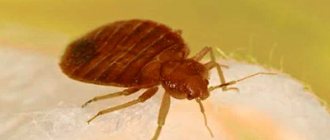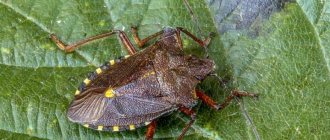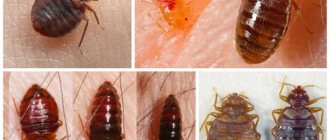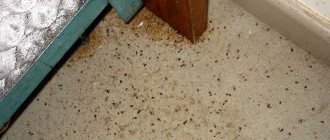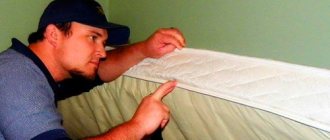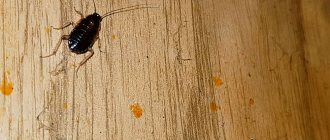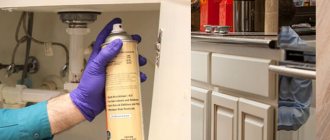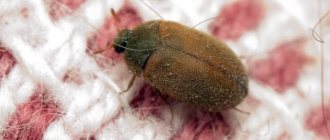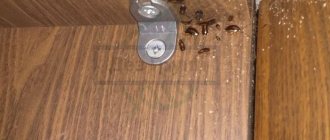A bedbug is one of the types of parasites that live in a person’s home. Their appearance is most often not associated with the pollution of the apartment and the presence of animals in it. Bed bugs can appear even in a perfectly clean living space. The fight against bedbugs must begin immediately after they are discovered, otherwise they will multiply and much more effort will be needed to remove them. To exterminate bedbugs, you can use both chemical and folk remedies. In this article we will talk about the main methods of control and remedies that have helped many families get rid of bedbugs in their apartments.
What do bed bugs look like?
A bedbug is a blood-sucking insect that is an ectoparasite of humans and warm-blooded animals. Wikipedia considers it from the point of view of an obligate synanthropic insect - its existence is completely connected with human life and housing. There are several types of bedbugs: black, white, brown.
If you already know firsthand what bed bugs look like and don’t want to learn their appearance and detection tips, you can skip straight to the extermination tips.
What do insects look like? The size of a bed bug ranges from 5 to 8.5 mm, with males always being smaller than females. Insects have a yellow, brown or dark brown color, which is directly caused by saturation with blood. The bug has a flat body, the front edge of the head is equipped with a special proboscis, which helps the insect pierce the skin and suck blood.
Stinging setae form the upper and lower jaws. They are divided into two channels: through the large channel, blood enters the body, and through the small channel, saliva is released for injection when bitten. To successfully exist in the vicinity of humans, house bugs are endowed not only with a miniature and flat body with low weight, but also with small notches on their paws, which allow them to move along walls and ceilings.
Many people are sure that bedbugs are able to fly and jump, but this is not the case; the bedbug does not have developed wings, and its legs are not adapted for jumping.
Determining enemy positions
Reconnaissance is a term used in military affairs. It means studying enemy positions. House bugs are just such an enemy, and in order to get rid of them yourself, you need to find out their location and number.
The obvious way is to wake up in the middle of the night from bites and turn on the light to see where the bloodsuckers are. However, this strategy may not be suitable, since a bug is not a mosquito; in the light of a lamp it will not sit on the wall, conveniently exposing itself to the clap of the palm. Moreover, according to statistics, 70% of people do not even notice that bed bugs drank their blood at night.
So, it remains daylight. If you notice blisters on the skin and blood stains on the sheets, the first thing you should do is inspect the bed. It is necessary to remove the sheets and mattress and shake them. If it is a sofa, then disassemble it, paying special attention to the corners of the frame and large seams. In addition to the parasites themselves, their presence will also be indicated by the shed skins that they change during molting, dark grains of feces and, of course, the smell. The aroma emitted by bedbugs has long been the subject of jokes: the little bloodsuckers smell like bad cognac or like fermented raspberries.
Bed bugs are synanthropic parasites; they feed on the blood of mammals. They identify victims by the heat emanating from them and try to arrange nesting sites close to, so to speak, the food supply. Therefore, a bed or sofa where a person spends 7-8 hours of sleep every day is an ideal option for them.
However, in order to be guaranteed to get rid of bedbugs at home, you should not limit your search only to a place to rest at night. It is also worth paying attention to the following:
- Cabinets. Inspect the area where the furniture touches the wall. Take clothes out of the closet and shake them out. Bedbugs are especially partial to synthetics.
- Bedside tables. It’s the same here – explore the space between the bedside table and the wall. It's a good idea to take out the drawers. There may be parasites there too.
- Bookshelves. Books are rarely read these days; they mostly gather dust on shelves. This is an excellent hiding place for bedbugs. Take out the volumes of Shakespeare and Shilova, and inspect the free space.
- Floors. There are many options here. Parasites can hide under rugs, carpets, parquet flooring, in the cracks between boards, behind baseboards and old or poorly glued wallpaper.
- Electrical appliances. Bed bugs love heat, including artificial heat. Therefore, sockets, switches, heaters and radiators are their favorite habitats.
If your search does not bring results, you can dilute vinegar essence and wipe it on plastic coverings, floors and baseboards. The solution must be strong enough to emit a strong odor. Synanthropic insects cannot tolerate it and will immediately be forced to leave their shelters. Then you can easily find them.
Lifestyle, nutrition and period of activity of the bug
How do bedbugs live and what do they eat? They lead a parasitic lifestyle, feeding exclusively on the blood of humans and warm-blooded animals. Insects are active only at night, and during the day they hide in dark, secluded places. Their nocturnal lifestyle helps them get close to a sleeping person unnoticed and easily choose the most suitable place for collecting blood.
The linen bug emerges from its hiding places between 1:00 a.m. and 7 a.m. It only takes 4 to 10 minutes for it to become saturated with blood, after which it leaves the human body and hides in a shelter. One “meal” of food lasts an insect for an average of 5–6 days. A bug that has drunk blood noticeably increases in size and can reach 9 mm. It is noteworthy that when fed, the bug becomes very clumsy and vulnerable, it loses its reaction speed and can be easily caught and crushed. This is why you can see blood stains on the bed; a thick and clumsy bug can be crushed even in your sleep.
The most developed sense organ of a bedbug is smell; it is able to sense carbon dioxide, which is released when a person breathes, at a distance of up to 3 meters, and the warmth of a sleeping person - at a distance of up to half a meter.
General information about the appearance of the insect
As noted above, bed bug (other commonly used names are apartment, linen, sofa, mattress, household, etc.)
is one of the types of bed bugs. It is widespread in different regions of the world, and its habitat coincides with that of humans. This is not surprising, given the peculiarities of the bedbug’s diet, which consists of human or animal blood.
The answer to the question of what an apartment bug looks like should begin by indicating the size of the insect. The length of the body of an adult varies widely - from 3 to 8-9 mm. As a rule, females are noticeably larger than males.
Depending on environmental conditions, quality and quantity of food, the color of the parasite varies from different shades of dull yellow to light and dark brown. The photo below shows a bedbug with a typical insect color.
Bedbug reproduction and lifespan
The reproduction of the household bug does not stop throughout the year. Fertilization of the female occurs in a very unusual way: the male introduces his seminal fluid through the integumentary tissue of the female, piercing her belly. The storage of seminal fluid by the female lasts throughout her entire life. She spends it gradually, laying up to 5 eggs per day. In total, a female bedbug is capable of laying from 250 to 550 eggs over its entire life cycle.
Bed bugs love to settle in mattresses, so their eggs can be found there, as well as on furniture seams, in fabric covers and other dark, hard-to-reach places. In appearance, the eggs are similar to small grains of white rice, which turn yellow as the embryo matures.
The fastest and most proven way to kill bedbugs inside a mattress is to use a special protective mattress cover. The product is a sealed case with a micro-zipper. By putting such a cover on your mattress, you will seal and thereby kill the insects inside, without resorting to disposal of the mattress itself.
The complete development cycle of the egg until the appearance of the larva is 7–10 days. If conditions are far from favorable, then the cycle can increase to 20 days.
Larvae are small bugs that absorb blood for the speedy onset of molting and the transition to a new level of development. When molting, the larvae shed their dark brown shells. Shed skins can be observed in places where parasites are most concentrated: behind sofas, in mattress seams, bedding fabrics, pillowcases. Before the larva becomes an adult, 5 moults must occur.
The larvae are not able to produce a special anesthetic secretion that adults secrete, so when bitten a person may feel a sharp, unpleasant tingling sensation.
Bedbug reproduction occurs faster when temperatures are favorable and the insect is provided with food.
How long do bedbugs live?
The lifespan of a bed bug ranges from 11 to 14 months. When hunger, low temperatures or other unfavorable conditions occur, bedbugs slow down their life processes and enter a state similar to suspended animation. They can remain in this state for over 12 months, while maintaining full viability.
It is noteworthy that bedbugs are able to migrate between apartments in search of more favorable living conditions. They easily crawl through ventilation holes, cracks in the walls of houses, chimneys, and in warm weather they move well along the outer walls of houses. An adult can walk 1 meter in 1 minute.
Deterrence and prevention
When choosing preventive measures, it is important to know that bedbugs are afraid of :
- bright light;
- low temperatures;
- dry or moist heat.
How to remove bedbugs from your home? A very effective method of control is freezing the room . The method is often used in rural homes; before the invention of industrial insecticides, it was the main method of killing bedbugs. The room remains open for 3-4 days at a temperature not lower than -20 degrees .
It is also practiced to fry bedding (feather beds, mattresses, pillows, blankets) in the bright sun. The method is less effective; the heat may not affect insect eggs. But they can be destroyed using a steam cleaner , which is used to treat furniture, frame joints, baseboards, and sofa cushions.
A simple and reliable method is to frequently wash bed linen, blankets, bedspreads, and furniture covers in very hot water . In this way, you can destroy not only eggs and adult bedbugs, but also get rid of insect waste products.
Before bringing old or antique furniture into the apartment, you need to carefully inspect all the hidden places: the bottom of tables and cabinets, the inside and back surfaces of drawers, grooves and joints, and check the furniture upholstery.
As preventive measures, you can use herbs with a strong odor: Persian chamomile, tansy, wormwood . Fresh or dried grass is laid out next to the bed, near the baseboards, on the window sills. Plants cannot destroy bedbugs that have already appeared, but they can protect premises from the invasion of insects from neighbors or from the street.
Instead of herbs, use essential oils with strong odors : clove, eucalyptus, mint, rosemary. They are used to treat ventilation grilles and spray mattresses and blankets. It is worth remembering that oils can leave permanent stains on fabrics.
Table vinegar or vinegar essence is often used as a preventive measure . The product coats areas of possible concentration of bedbugs; it will have to be renewed frequently, since the pungent odor that repels bedbugs quickly dissipates.
What do bite marks look like?
A roombug, when saturated with blood, can make up to 7 bites at intervals of 1 – 2 minutes. Thanks to the anesthetic saliva secreted, a person often does not feel a bedbug bite. Traces of bedbug bites on the human body can be distinguished by a characteristic line of closely spaced red dots, which can be compared to mosquito bites. Itching and burning of the bite site is an individual symptom that may not appear. A large number of people do not experience any physical discomfort associated with the bite.
A characteristic symptom of a bite is redness of the bitten area and its thickening. This differs from a mosquito bite, traces of which disappear from the human body within a few hours.
Most often, bites occur on less protected areas of the body with delicate skin - the neck, shoulders, and back.
Special services to combat bedbugs
If we talk about emulsion concentrates, many of them are used by professionals from pest control services. This suggests another thought. Before you start removing bed bugs at home yourself, it’s worth asking yourself: will the small savings in money compensate for the volume and difficulty of the work that needs to be done? Are there any risks associated with it, not completely removing bedbugs, choosing the wrong drug, getting mild poisoning? If in doubt, you should call special pest control services. Professionals will do it better. But in this case, you need to look for a professional, and not a private trader with a sprayer or a bucket with a broom.
Are bedbug bites dangerous for humans?
Scientists have not proven the danger of a bedbug bite and the serious diseases it carries, but there are organisms that are carried by bedbugs and can cause diseases such as:
- brucellosis;
- smallpox;
- Hepatitis B;
- tuberculosis.
What to do if bedbug bites itch very much and instantly increase in size, weakness, nausea and dizziness occur? An allergy to an insect bite should be excluded. In the absence of timely medical attention, allergies can lead to the development of complications after a bite, including anaphylactic shock.
Bed bugs are carriers of infections, but there have been no cases of them infecting humans. Quite often, infection occurs by the person himself when scratching the blisters and introducing microbes into the wounds.
Bedbug bites cause nervousness, malaise, and lack of sleep. A person loses his former ability to work, the quality and pace of life decreases. Constant psychological discomfort can transform into prolonged depression.
Specifics of a private house
For this reason, by the way, it is somewhat easier to remove bedbugs forever from a private detached house. Simply because bedbugs themselves do not move between individual buildings and cannot crawl here from neighbors, even if there are any cracks and holes in the house. That is, either you bring bedbugs into the house yourself, or they don’t get here at all. People always bring bedbugs to the same dacha themselves.
On the other hand, it is usually more difficult to exterminate bedbugs in houses due to the larger area and the greater number of hiding places there. Sometimes old houses have wooden floors under which bed bugs need to be very carefully treated with insecticides.
As a rule, in a private house it is not possible to remove bedbugs on your own forever precisely because here a person cannot find all the hiding places of the bedbugs and poison all the insects. After treatment, surviving bugs continue to reproduce and gradually restore their numbers.
But in any case, this is a solvable problem, because all this can be done by a conscientious sanitary service specialist, and with great desire and diligence, you can do it yourself.
We treat bedbug bites, remove bite marks
Bed bug bites not only bring discomfort and unpleasant sensations, but also look unsightly on the skin. In order to get rid of the first symptoms of a bite and reduce inflammation, it is recommended to rinse the bitten area with clean water and then treat it with a solution of vinegar or citric acid.
To relieve the skin from itching, you need to soap the bite area with glycerin soap and let the soap foam dry a little. After 7-10 minutes, rinse the bite site with warm running water.
To treat skin bites, a prepared mixture of baking soda and water will help. Apply the paste mixture to the affected areas of the body and leave for 30 - 50 minutes, then rinse off with warm water.
In order to reduce the rash, you can use lemon juice or St. John's wort decoction. It is enough just to lubricate the bite area with cotton wool a few times.
To prevent the development of infection, it is recommended to apply a gel containing aloe vera juice to the affected areas of the body. A special gel, Gektor, after bedbug bites, is ideal for this purpose. It relieves redness and promotes rapid healing of wounds, restoring a healthy color to the skin. The gel is applied in a thin layer to the damaged area.
The ointment after bites, which contains hydrocortisone and cortisone, effectively removes traces of bites. It promotes the resorption of blisters, relieves itching, and reduces pain.
Allergic reactions and swelling of the skin can be relieved with antihistamine tablets such as Benadryl. It must be taken into account that they have contraindications that can lead to exacerbation of chronic diseases.
If the reaction to a bug bite is accompanied by a rise in temperature, fever, nausea, muscle weakness and headaches, then you should immediately consult a doctor for qualified medical care.
Is it possible to remove bedbugs forever?
Bedbugs can and should be eliminated forever. These insects, with their bites, deprive a person of peace and normal rest. Their bite can cause not only severe itching and allergies. If you scratch too hard, the wound can become infected.
To combat bedbugs use:
- insecticides;
- folk remedies;
- thermal impact.
To remove parasites, you can use all methods for different cases. Not all of them work the same and give different results.
What causes bed bugs?
Every person who has ever found bites on their skin has wondered where bedbugs come from in their apartments. After all, a well-kept apartment not inhabited by pets and located far from garbage dumps is not a guarantee of safety from bed bugs.
How do bedbugs appear in the house? The main source of their spread is neighboring apartments. This problem is especially relevant in old buildings, Soviet high-rise buildings and communal apartments. Bedbugs move quite actively, capturing new territories to inhabit.
In rural areas, bedbugs appear in barns, chicken coops, poultry houses, and then safely move into human habitation.
Due to their high adaptability to unfavorable environmental conditions and good viability, bed bugs can enter the house in a variety of ways:
- From a trip . Traveling to warm countries, the risk of getting bed bugs is quite high. It is enough to bring one adult female in a suitcase or backpack and after a while the apartment will be densely populated with blood-sucking insects.
- Furnished . When buying used furniture, a person also runs the risk of acquiring bed bugs. Bloodsuckers often settle in sofas, armchairs and poufs, since it is on this furniture that their potential victim is located.
- With clothes . Bedbugs hide in the folds of clothes, so trying on something in a store can bring back an uninvited guest. Also, used clothing stores are at risk, so after purchasing used clothing, you must thoroughly steam it.
- With household appliances . Bedbugs like to wait out the daytime in secluded places, which serve as reliable protection for them. Laptops, TVs, microwave ovens and other equipment are good shelters for bedbugs; they often even lay eggs in the openings of household appliances.
- On animals . Bedbugs very rarely parasitize animals, but there have been cases of them being carried by domestic animals and birds.
Bedbugs live in shops, warehouses, libraries, clinics, offices... Often, people don’t even notice small insects until their population reaches a huge number.
Bedbug nests in the photo
Actually, bedbugs do not form organized nests like wasps and especially ants. They simply hide during the day in the most suitable places, and since there are much fewer such places in the room than there are bedbugs themselves, these parasites can accumulate in huge quantities in the most comfortable shelters. In these places there are the bugs themselves, both adults and nymphs of all ages, eggs, remains of the chitinous covers of the larvae, excrement, and in general they look very unpleasant.
For example, here is a typical bedbug nest on a sofa upholstery:
And here the video shows the same accumulation, only on a blanket, which is generally atypical for bedbugs - they prefer to settle on stationary surfaces that are not disturbed by people:
Here is another place for bedbugs to hide, rest and breed, which completely covered one side of the mattress on the bed:
The largest such “nest” that we saw caught the eye of exterminator Kostya in an apartment near Moscow - it was about 80 cm in diameter and was located in the sofa. It is difficult to say how many parasites there were in it, but the sight was, to put it mildly, repulsive.
By the way, this is what a cluster of small larvae looks like right on the mattress:
It was precisely these young individuals that the students we have already mentioned mistook for some strange spiders. But they were definitely sure that these were not bedbugs.
Such hiding places cannot be called nests, because there is no organization or order in them. For example, in the nests of wasps, termites or ants, strict order reigns: the queen lays eggs, the workers look after her, the brood, the nest itself, obtain food, and protect the nest from enemies. All this is not present in bedbug clusters:
- There is no queen that lays eggs alone - all adult females lay them;
- There are no individuals who would maintain order here - everything in such a shelter accumulates spontaneously, complete disorder reigns here;
- The nest is not protected in any way by anyone, and when it is opened, some of the bugs try to run away, the other part hides, hoping that they will not be noticed;
- There is no hierarchy in such a cluster. Bedbugs simply accumulate here, spend daylight hours here, reproduce and die here.
By the way, you have probably already noticed that almost everywhere in such places of accumulation you can see black dots that look like balls. You probably already guessed what it is...
Where do bedbugs hide - habitats
You can determine the main habitat of bed bugs by their name; of course, this is the bed. Bed bugs live under the mattress, in the folds of bed linen, pillow seams, and bedside tables. They are especially attracted to sofas and armchairs with soft upholstery, in which they safely accommodate their entire colony.
The main criterion for such placement is proximity to the power source, namely to the sleeping person. In bedrooms, a comfortable temperature is most often maintained, which allows bedbugs to actively reproduce.
Where do bedbugs hide? They usually settle in hard-to-reach places such as:
- cracks in linoleum;
- parquet cracks;
- linen closets;
- carpets, rugs;
- bookshelves;
- upholstered furniture;
- Appliances.
You can find bedbugs under baseboards, behind wallpaper, in wardrobes and even in electrical outlets.
Several cases from practice
In March, four months ago, we worked in Mytishchi; a woman herself removed bedbugs from an apartment for two years, but did not remove them. Twice exterminators worked in front of us, each time they killed the bedbugs, but after a month or two they appeared again.
We checked our order database, half of the apartments in this building are or were infested, that is, one of the neighbors constantly has bedbugs.
During the treatment, the exterminator got confused, checked everything, found two cracks in the heating risers, and a crack in the box in the toilet where the toilet flush goes into it. The woman immediately sealed these cracks with sealant during treatment. Four months have passed. Not a single parasite was seen in the apartment. The customer is happy, her children and no one bites her, she recommends us to friends, says how well we carry out the treatment. But in reality, the whole secret was in this sealant putty.
Standard organization for introducing heating risers into a room - in the gap between the pipes, bedbugs could skip (if they could jump)
There was an interesting incident in another apartment. It was a dead-end apartment in an old building, and it was very well renovated, literally perfect walls, perfect joints, ceilings, ventilation grilles. And a person has the same problem: it turns out that there are no bedbugs, but after a month or two they appear. He poisons himself, orders treatments - the result is the same.
We checked all the risers and sockets in the apartment - everything was sealed, everything was clean. We looked at the front door - there was no rubber seal on it. A good metal door, solid, but without elastic. They started checking it with a sheet of paper, and it turned out that when installing it, the box moved a little. It is not visible to the eye, the curvature occurred on the side opposite the hinges, that is, this curvature does not affect the opening and closing in any way. But there is a gap.
The next day the customer went to the market, bought an elastic band for the entire perimeter of the door for 200 rubles, it cost 200 rubles. He glued it on. This was after the New Year, more than six months ago. After this he has no bedbugs. Not because we carried out the treatment so well, not because the product was 12,000 rubles per liter, but because they can no longer get to it.
And there are many such situations. Somewhere you need a cheap tube of silicone for 150 rubles. Somewhere an elastic band costs 200, somewhere a grille costs another 200. Plus, it takes half an hour to do it. And that’s it, then carry out normal treatment and forget about bedbugs forever.
There are, of course, cases when bedbugs are reintroduced by people themselves. But in reality, if a person once had bedbugs in his house and was able to get rid of them, then this is usually such a negative experience that in the future, in situations where bedbugs can be accidentally brought in with things or furniture, the person will be extremely careful to prevent this. Did not happen. He will wash things, check bags after trips, will not buy used furniture, and most likely he will not bring bedbugs into his home.
How to independently detect the presence of bedbugs in a room?
Independent detection of bedbugs indoors is difficult because the arthropods are very small and nocturnal. But by paying attention to some characteristic signs, you can still recognize insects:
- The appearance of bites on the body is the main sign that there are bed bugs in the apartment. To distinguish bedbug bites from mosquito bites, you need to look closely to see if there are small droplets of coagulated blood on them. When bitten, a mosquito secretes a hemostatic mucus, which the bug does not have. The bug only numbs the bite site, so blood particles remain on the wound.
- Blood stains on bed linen. A parasite that has drunk blood becomes very large and clumsy. It moves slowly and can easily be crushed by a sleeping person. In the morning, if you look closely at the bed linen, you can see small blood spots.
- The presence of black spots - bedbug excrement. They can be on the sofa, in bedside tables, wardrobes.
- The keratinized membranes of parasites that remain after they molt. The shells can be found in areas with large concentrations of insects and excrement.
- Live insects, eggs, larvae. To detect adult individuals, you need to lay out the bed and turn on the lights sharply at night. Insects will definitely be noticed, as they will not have time to hide.
To simplify the search for pests, it is recommended to use a flashlight and a magnifying glass. It is necessary to examine all hard-to-reach places in the house. A magnifying glass will help in identifying excrement, eggs and larvae.
Bedbug trap
Unfortunately, bed bugs are quite difficult to attract with anything. Therefore, now there is only one type of trap on sale, which uses your sleeping place as bait. Such traps are plastic containers with a special “catching groove”.
The trap should be placed under each of the bed legs, and the bed itself should be moved away from walls and other furniture. Bed linen should never touch the floor. If all this is done, then bed bugs will have no other option but to crawl up the legs of the bed.
The bug, having climbed to the top along the outer rough side of the trap, encounters an obstacle in the form of a groove with a slippery surface. An insect thirsty for blood cannot understand in time that its legs are unable to grasp such a surface. Trying to get through the obstacle, the bug slides down, from where, for the same reason, it cannot get up.
This trap is usually sold in a set of 4 pieces.
Preventive measures (prophylactic)
The location of the enemy has been determined, it’s time to choose a weapon to destroy it. To get rid of bedbugs yourself, you can use four methods: mechanical, folk, temperature and chemical.
As a rule, by mechanical method we mean a slipper and a vacuum cleaner. The first to hit the bugs is the second to suck them out.
Folk remedies are suitable for those who, due to circumstances, do not have access to stores where they sell chemicals, or who fundamentally do not want to spend money on them.
Such people can take advantage of the gifts of nature. It is known that bed bugs cannot tolerate the smell of wormwood and tansy. Therefore, it is necessary to spread these plants in places where parasites accumulate and after a while they will retreat from there. True, you should be careful with tansy. It is moderately toxic, so during procedures, it is not superfluous to ventilate the room, and keep children and pets at a distance.
These herbs act not only on bed bugs, but also on mosquitoes and cockroaches. Which is definitely a plus. The downside is that both wormwood and tansy repel parasites, and do not kill them. The enemy moves to another place, but after a while he will undoubtedly return to continue to pester you with bites.
Also, such chemicals as kerosene, cresol, denatured alcohol, ammonia and sting were widely used among the people. Separately, and especially as part of mixtures, these substances can not only repel bedbugs, but also destroy them along with the larvae and sometimes eggs. However, treating a room with them is time-consuming and inconvenient; they smell strongly and damage upholstered furniture.
In general, experts are increasingly less likely to recommend their use. The reasons are simple - they are much inferior to professional chemicals, some of them emit toxic fumes, others are flammable. So it is neither possible nor safe to get rid of bedbugs with kerosene or vinegar at home.
The best modern chemicals for bedbugs
The unpretentiousness of insects and their ability to live in the most unpredictable places makes the fight much more difficult. To remove bed bugs, it is recommended to use proven and effective chemicals. Next we will look at some of them.
Here's what an employee of one of the capital's pest control services said:
Oleg Roshchin
I am a professional exterminator, I have been removing insects from apartments and private houses for 7 years.
Moscow bedbugs have unimaginable resistance to drugs. Our branches in the outback never cease to be surprised - they say you have bad bugs. Resistance to the drug develops from the second generation: if the parents were poisoned with one drug, it will no longer affect the offspring of bedbugs. Therefore, we have to constantly change processing agents.
Gektor
Hector is probably one of the most popular and modern remedies against bed bugs. The product was able to achieve this thanks to its unsurpassed effectiveness, as can be seen by reading numerous customer reviews. The drug is presented in the form of a powder based on silicon dioxide SiO2. The main feature is the principle of action - the product dries out bedbugs, completely dehydrating them. The drug is safe for use in apartments and private homes. There is a caveat - the product does not work instantly, and the effect appears after about a week, but it lasts for a long time.
Karbofos
Karbofos has a nerve-paralytic effect that helps remove bedbugs. Once on an insect, the substance immobilizes its muscular system, which leads to the death of the parasite. You need to know that Karbofos is a very stable product; when applied to interior items, the paralytic effect lasts for up to several months, which can pose a danger to children and animals. When using this substance, you must carefully read the instructions.
Get Total
Get Total will help get rid of bedbugs, cockroaches, fleas, ants and many other insects and will maintain the effect for up to 6 months (as the manufacturer claims). The instructions advise you to first clean the room, find areas where parasites have spread, pour boiling water or hot steam over them, and then thoroughly treat them with the drug. It is also very important to close all escape routes for bedbugs: cover cracks in baseboards and walls with masking tape, close hoods and joints of walls and communications. Then treat the entire apartment with a product diluted according to the instructions. Active ingredient: chlorpyrifos (5.0%). One bottle of the drug is enough for 20-22 sq.m.
Dichlorvos
Dichlorvos is an aerosol intexicide, which is available in cans. Aerosol is the best remedy that helps to quickly get rid of bedbugs. Surfaces pollinated with a spray retain insecticides for a fairly short period of time. To increase effectiveness, repeat the treatment several times a week. It is necessary to spray places where insects accumulate and where they might live. After spraying, you must immediately leave the room for 40 - 60 minutes, and then ventilate the apartment. Dichlorvos must be used following safety precautions.
Hot fog
Hot fog is the fastest and most effective way to get rid of bedbugs today. The chemical is poisonous, so it is recommended to call a special service for treatment. This method consists in the fact that the destruction of bedbugs occurs with any preparation heated to 80-90°C, which is sprayed indoors.
Hot fog heats the temperature in the apartment to 50°C; a fatal temperature for a bedbug is 45°C. Disinfection will take an hour on average, but suspended particles of the drug will settle within 3 to 7 hours. The descending particles must act on the eggs and larvae for at least another 4 hours to destroy them. Only after 8 – 11 hours can you begin wet cleaning of the room.
Xulat Micro
Xulat Micro is popularized as a remedy for home use against bedbugs and cockroaches, with which you can get rid of insects yourself. It is one of the microencapsulated preparations: after the liquid dries, the intexicides form a thin film on the treated surface.
Microcapsules stick to insects running across the surface, leading to poisoning of their body.
Cold and hot war
Bed bugs are heat-loving insects that feel comfortable at 20-25 °C. They tolerate any temperature fluctuations painfully. For example, a cold snap of just 10 °C puts them into suspended animation; at -20 °C and below, their bodies freeze, and after a few hours the frozen organs rupture the internal tissues, leading to the death of the insects.
However, bedbugs like warmth for the time being. As soon as the thermometer rises to +55 °C, the parasites begin to feel uneasy. An hour or two in this heat and they die. A day later, the same fate overtakes the eggs they laid.
It would seem that freezing and evaporation could become the most popular means. With their help, you could easily get rid of bedbugs yourself and without special costs: you don’t need to buy chemicals or contact pest control services. However, in real life, it is not so easy to exterminate parasites with cold and heat.
Killing by cold requires a consistently low temperature outside. The windows are opened wide, the heating is turned off, the water is drained from the pipes so that it does not freeze and break communications. Freezing is carried out in two stages: the first time the population of adult individuals must die, the second time - those bugs that manage to hatch from heat-resistant eggs in about 2 weeks. If everything is done correctly, the blood-sucking enemies, as well as their eggs, will disappear forever.
But such a powerful effect will also have a downside. Freezing temperatures can ruin plaster, furniture, wallpaper or cause other costly damage. Therefore, freezing is only suitable for local control of parasites. Let's say bedbugs have infested the sofa and have not yet spread throughout the house. The furniture is taken out into the cold and left under the windows for a day. The result: no parasites, no chemical smell, just the aroma of frost on the upholstery.
Things are not so simple with the evaporation of bed bugs. To say that using this method to easily get rid of bloodsuckers at home would be an exaggeration.
For this procedure, a steam generator apparatus is used. The temperature is set to 60 °C and above; it is advisable to wrap the nozzle with a rag so that water vapor is sprayed at a wide angle. A jet of steam quickly kills bedbugs, their larvae and eggs, but the treatment process itself takes a lot of time, since with the help of a steam generator you can only hit bedbugs with targeted blows, and only in open areas: by removing a panel from the wall or rolling up a carpet on the floor. It will not be possible to crawl with such a unit into the far corner of the bedside table or treat the socket with a stream of steam. In addition, steam is harmful to paint surfaces, and at temperatures above 70 ° C, also to plastic coatings.
Therefore, as with freezing, evaporation is suitable for controlling bed bugs in a confined space when they have not yet spread throughout the room. Otherwise, only a temporary effect can be achieved - the remaining individuals will reproduce and quickly restore the population.
How to prevent the spread
To stop the reproduction process, you need to create unacceptable conditions for this. The main factor is temperature difference. Conditions within +25…+35°C are considered comfortable for parasites. When the temperature is lowered with the help of an air conditioner to +18 and below, the development of insects slows down and the reproduction process is inhibited.
This will prevent the spread of insects until the bedbug nests on the sofa are destroyed.
When introducing pests, it is necessary to find their habitat. If it is destroyed, the number of insects will decrease many times. This is the fastest way to control pests in your home and also prevent further spread of insects.
Find all bed bug nests inside the sofa
Sources
- https://vreditelstop.ru/klopy/kak-bystro-izbavitsya-ot-divannykh-klopov.html
- https://prusakam.net/kak-vyvesti-klopov-iz-divana/
- https://medilis.ru/articles/klopy/kak-vyvesti-klopov-iz-divana.html
- https://Vladimir-SES.ru/klopy/kak-vyvodit-postelnykh-klopov
- https://mblx.ru/mjagkaja/kak-izgotovit/1139-kak-izbavit-sya-ot-klopov-v-divane.html
- https://dezincity.ru/klop/unichtozhenie/kak-izbavitsya-ot-klopov-v-divane
- https://BezTarakana.ru/chem-vyvesti-klopov-iz-divana-v-domashnih-usloviyah/
- https://comfort-da.ru/kak-izbavitsja-ot-klopov-v-divane/
- https://ouborke.ru/kak-samostoyatelno-vyvesti-klopov-iz-divana
- https://ria.ru/20210920/klopy-1751050211.html
- https://severdv.ru/sovety/kak-vyvesti-klopov-iz-divana-samostoyatelno/
- https://masterklop.ru/klopy-v-divane/
- https://BezNasekomyh.ru/klopy/postelnye-klopy/klopy-v-divane-ili-kreslakh
- https://parazitdoma.ru/klopy/divannye
- https://notklop.ru/klopy/unichtozhenie-klopov/klopy-v-divane/
- https://combat-dez.ru/kak-vyvesti-klopov-iz-divana/
- https://Otbelim.com/vrediteli/klopy/kak-izbavitsa-ot-klopov-v-divane.html
- https://misterklop.ru/klopy/klopy-v-divane-kak-najti-i-vyvesti-samostoyatelno
What smells do bedbugs dislike?
Bedbugs have a highly developed sense of smell. This helps them quickly find a source of nutrition - human blood. Therefore, insects always react to odors and do not like highly concentrated aromas. This was discovered a long time ago and was used to repel blood-sucking insects. Smells that bed bugs are afraid of include herbal aromas:
- wormwood;
- tansy;
- calamus;
- chamomile;
- wild rosemary
The scent of perfume and cologne can also ward off an uninvited guest. But only if the smell is very persistent. Among the chemical agents to repel bedbugs, you can use ammonia, vinegar, turpentine, wiping the legs of the bed and the floor around it with their solutions.
Comment! Repelling bedbugs with an unpleasant odor is only a temporary measure. A very hungry insect will still attack a person to satisfy its hunger.
What to do with things that cannot be treated with insecticides?
Treatment with chemicals is not acceptable for all things. For example, insecticides should not be used to kill insects that hide in clothing and bedding. Some home furnishings, electronics and household appliances may break due to contact with chemicals.
How to kill bedbugs in textiles? To do this you need:
- wash all clothes and bedding in a washing machine at +60 degrees or higher;
- when things are dry, iron them with an iron with steam or a steam generator;
- It is better to take large items, such as pillows, mattresses, blankets, to a professional dry cleaner or to a disinfection chamber.
This set of measures will allow you to kill larvae and adults and get rid of eggs on textiles.
